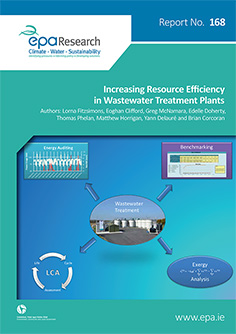Authors: Lorna Fitzsimons, Eoghan Clifford, Greg McNamara, Edelle Doherty, Thomas Phelan, Matthew Horrigan, Yann Delauré and Brian Corcoran
Summary: The focus of this project was the resource efficiency of Irish wastewater treatment plants (WWTPs). The perspective of the report is both operational (economic) and environmental. Wastewater treatment is a resource-intensive process, with three main resources being identified as those of greatest concern: energy, chemicals and water.

This research adopted a multi-pronged approach to audit and benchmark the resource efficiency of Irish wastewater treatment plants (WWTPs), including the use of life-cycle analysis (LCA) and exergy analysis. Ten representative Irish WWTPs were audited in detail. The plants varied in scale, with regard to their design capacities, from 600 PE to 186,000 PE. Simultaneous energy and resource consumption and water quality audits were undertaken, resulting in the development of benchmarking tools and auditing methodologies, and the detailed performance evaluation of the plants to support better resource management and to provide baseline data with regard to the holistic performance of the WWTPs. The results of this research should be of interest to Irish Water and other water utilities, the EPA, WWTP managers, researchers, and policymakers inter alia.
Wastewater treatment is a resource intensive process utilising several inputs such as energy, chemicals and water to producean effluent that meets designated environmental standards. Driven by environmental regulations, the focus of wastewater treatment plants (WWTPs) has traditionally been the quality of the effluent and not necessarily energy or resource efficiency. Regulation and penalties incentivise the meeting of environmental effluent standards; however, to date, there are no such analogous penalties or incentives to expedite the focus on resource efficiency. It is imperative to recognise that resource utilisation and indeed sludge management also have significant environmental consequences, and therefore WWTP performance should be viewed holistically.
The development of effective environmental wastewater treatment policies is dependent on a holistic understanding of the environmental impacts of wastewater treatment. Knowledge of these impacts in turn relies on accurate data to quantify the resources consumed to treat wastewater to the designated standards, and the impact of this broader consumption on the environment.
A suite of software tools to assist WWTP benchmarking and performance management was developed and tested:KPIAdvisor and KPICalc. The tools are easily accessible, highly automated, and suitable for implementation in WWTPs of varying treatment processes, population equivalent, staffing numbers and resource consumption. In addition, the toolkit can assist stakeholders in the identification of faults in data acquisition methods, offers users an incentive for improving data acquisition methods, and is flexible in terms of the frequency of data. Effective and efficient operation of WWTPs is best achieved at the design phase, when the longer term life cycle costs and performance of the WWTP are anticipated and optimised, rather than solely focusing on the initial capital costs.
The key recommendations are as follows:
The publications arising from this research are listed at the end of the report.
https://www.epa.ie/media/epa-2020/publications/research/EPA-Research-Report-168_cov_20mm[1].jpg